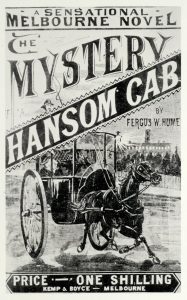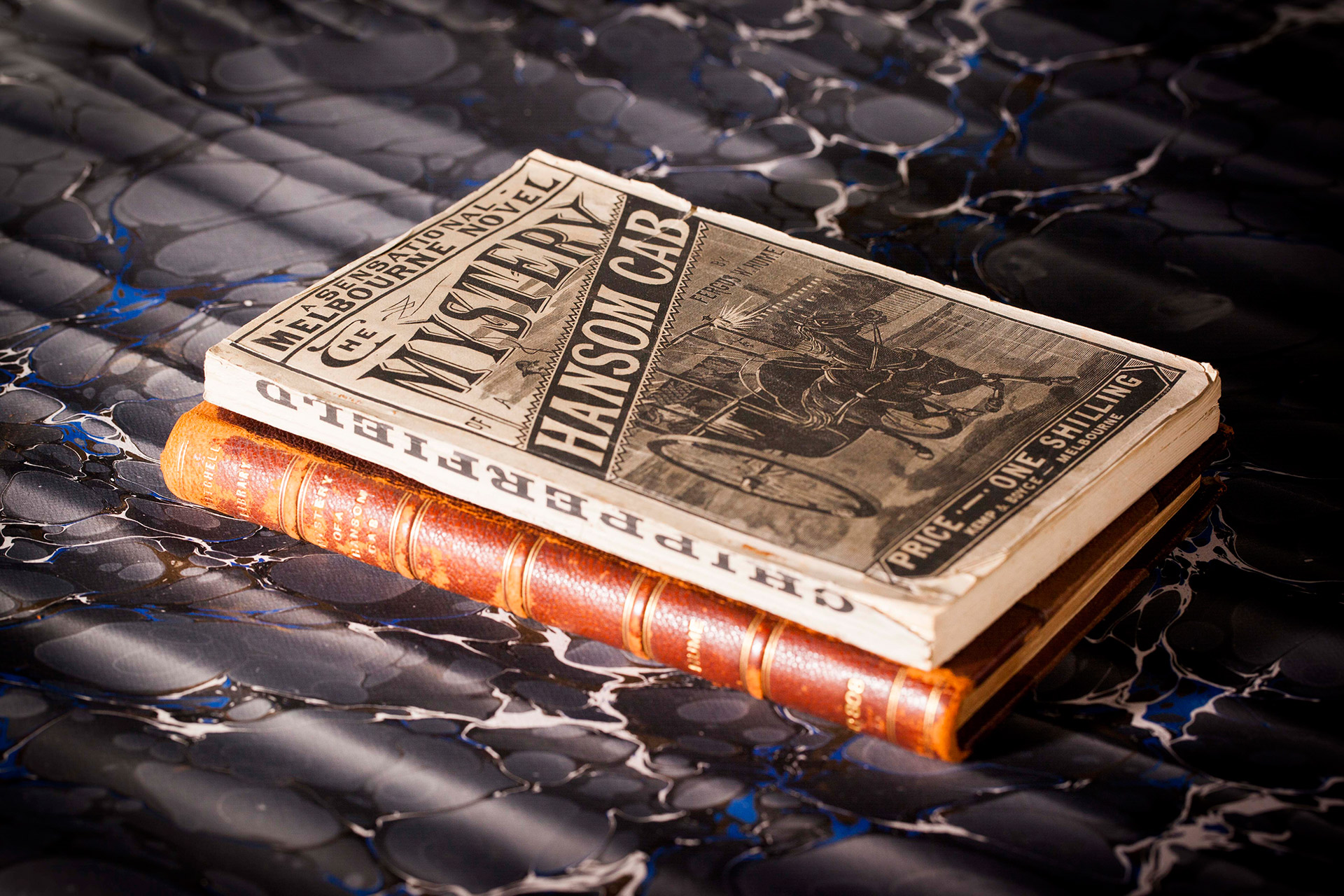When a man is found dead inside a cab with a strange note inside his pocket, will two rivaling detectives be able to catch the murderer when they don’t even know the victim’s identity?
This is the premise of Fergus Hume’s 1886 mystery, The Mystery of a Hansom Cab. Set during the mid-late 1800s in Melbourne, Australia, the novel follows Detective Kilsip as he tries to solve the murder of Oliver Whyte. If you’re a fan of classic detective novels, you’ll enjoy this precursor to Arthur Conan Doyle’s Sherlock Holmes.

Image of book cover, Source Image
The novel opens on a murder. An unidentified man gets into a cab, which immediately sets off toward its destination. When it arrives, however, the cab driver discovers the man to be dead. With nothing to identify the victim, and nothing to hint at who killed him or why, the mystery seems unsolvable. Two rivalling detectives are put onto the case: Gorby, a fat and somewhat incompetent man, and Kilsip, a thin, stoic individual who distances himself from people. When the victim is finally identified as Oliver Whyte, the detectives bring in Brian Fitzgerald, a major suspect. With the introduction of Brian comes the introduction of the Frettlby family, and the introduction of another mystery. Mark Frettlby, the patriarch of the Frettlby family, holds a dark secret from his daughter, Madge, and his future son-in-law, Brian. To find out who killed Oliver, Kilsip and Gorby will need to first uncover this secret, which may ruin a young woman’s life forever.
The Characters
Samuel Gorby is the first detective we are introduced to. He is eccentric, and enjoys talking to himself. He is described as fat, stout, and likeable. People tended to trust him, which made him good at discovering secrets. However, he catches the wrong criminal, and he is mostly incompetent, especially when compared with Kilsip.
Detective Kilsip is the second detective that we are introduced to, but he is the main detective of the novel. He is described as being tall and slender, and he usually has a hard time getting people to open up to him. He is a rival of Gorby’s, and will often try to solve a case just to outwit him. He is the one who unravels the real mystery of the novel.
Brian Fitzgerald is a young Irish business man who is engaged to Madge Frettlby. Because of a major fight that he had with Oliver, he is one of the biggest suspects in the novel. His fiancée, Madge Frettlby is the heiress of the Frettlby family. She is a young clever woman who is engaged to Brian. She turns amateur detective during the novel, and proves herself quite capable. These two introduce the major drama of the novel. The secret that revolves around this couple is what pushes the plot forward, and what makes the book impossible to put down.
The Novel
Truth is said to be stranger than fiction, and certainly the extraordinary murder which took place in Melbourne on Thursday night, or rather Friday morning, goes a long way towards verifying this saying.1
The Mystery of a Hansom Cab, while somewhat of a slower read, was well-written. It had beautiful imagery of Melbourne, and the characters were fleshed in a style common in the Regency era. I was surprised that I enjoyed reading it so much. The beginning of the novel was slow, and it does take a bit of work to get to the more interesting parts of the story, but once there, I couldn’t put it down. I was intrigued to know the mystery behind the Frettlby family. While this was a mystery novel based on a murder, I found myself not really all that curious as to who killed Oliver Whyte or why. I was much more curious to know what was happening with Mark and Madge. Whether this was the intent of Hume, I’m not sure, but he was successful in creating a riveting drama. I was surprised to find out the family’s secret, although I can’t say it was altogether unpredictable, given the time period.

Image of two books, Source Image
The novel’s main theme is the disparity in social class and wealth. The distinction between the upper and lower-classes were significant, and held a lot of implication for the novel. Because of that, I would suggest this novel for anyone interested in Jane Austen. Her novels often address social class issues through characterization. Hume does the same in Mystery of a Hansom Cab. I would also recommend his work to anyone who likes Émile Gaboriau. Gaboriau was a huge influence on Hume’s work, and it shows in his writing. If you aren’t familiar with Gaboriau, it’s important to note that he was the creator of the detective, M. Lecoq, and is recognized as the father of the police novel.
Before writing this novel, Hume had asked his publisher what kind of books were selling. He wanted to write something that would be popular. The publisher had told him that Gaboriau’s mystery novels were very popular, and so Hume went out and read all of his work. He was determined to write like Gaboriau, as to assure his success.1 By “drawing on the influence of crime writers such as Emile Gaboriau and featuring the first appearance of a recurring detective, the novel was a huge and immediate commercial success and promised future fame for its author.”2 Selling more than 30,000 copies in less than six months,2 Hume was well on his way up. After his first major success with Mystery of a Hansom Cab, Hume went on to write more than 130 novels.2 He was extremely popular with the public, although nothing beat the popularity of his first novel.
Hume did a lot for the mystery genre. He turned many readers onto crime fiction, and he had publishers out looking for more of it.3 In Detective Kilsip, he created “a strangely unsympathetic character who thinks nothing of letting a murderer go free if it means he can score points off his rival. In this respect, Hansom Cab anticipates that other crime narrative of the new world—the American hard- boiled novel in which the detective’s moral scheme is ambiguous.”2

Image of Fergus Hume, Source Image
Hume can be seen to anticipate the hard-boiled school of Dashiell Hammett in his realistic depiction of the legal system and the mingling of domestic, criminal, and professional milieus.3
We owe a lot to Fergus Hume for making crime fiction so popular with the public.
The Adaptations
If you aren’t big on reading, The Mystery of a Hansom Cab did inspire numerous adaptations. One of the most recent adaptations was a 2012 TV movie starring John Waters as Mark Frettlby and Shane Jacobson as Detective Gorby. While there are other adaptations, this fast-paced and entertaining film might be better to entice a more modern-day audience.
Final Verdict
Because of the difficulty I had in procuring a non-digital copy of this book and the lack of reviews or plot summaries online, I was expecting this book to be a slow and painful read. While the beginning was a bit boring, and it did take some work to really get into the plot, this book surprised me in how compelling it was. While I didn’t care about the main crime or who killed Oliver Whyte, I did care about the family secret revolving around the Frettlby family. Halfway through the book, I found myself not willing to put the book down. I needed to know the ending. When I finally reached the conclusion, I was surprised to find myself as shocked as I was. I had actually enjoyed reading the novel, and while I wouldn’t suggest it to everyone, I would actually consider recommending this book to others. Be warned that finding this book in a non-digital version that has an aesthetically pleasing cover is extremely difficult, especially if you don’t want to spend a lot of money. I would go with the digital Kindle version, which is less expensive, and easy to procure. If you enjoy classic detective novels, and don’t mind working a bit to get into the plot, I would highly suggest reading The Mystery of a Hansom Cab.
1Hume, Fergus. The Mystery of a Hansom Cab. Columbia, SC, 2017.
2Pittard, Christopher. “The Real Sensation of 1887: Fergus Hume and The Mystery of a Hansom Cab.” Clues, vol. 26, no. 1, pp. 37–48., Accessed 12 Sept. 2017.
3Server, Lee. “Hume, Fergus.” Encyclopedia of Pulp Fiction Writers, Facts On File, 2002. Bloom’s Literature, online.infobase.com/HRC/Search/Details/47989?q=mystery of the hansom cab. Accessed 12 Sept. 2017.
Bibliography
Dirda, Michael. “Book review: The 1886 ‘Mystery of a Hansom Cab’ has murder and a kitschy charm.” The Washington Post, WP Company, 26 Mar. 2014, www.washingtonpost.com/entertainment/books/book-review-the-1886-mystery-of-a-hansom-cab-has-murder-and-a-kitschy-charm/2014/03/26/7ea75cfe-b42b-11e3-b899-20667de76985_story.html?utm_term=.b88e3fdee314.
Hume, Fergus. “The Mystery of a Hansom Cab.” By Fergus Hume, www.goodreads.com/book/show/939437.The_Mystery_of_a_Hansom_Cab.
Louttit, Chris. “The Mystery of a Hansom Cab, the Classic Adaptation and the Australian Canon.” Adaptation: The Journal of Literature on Screen Studies, vol. 9, no. 1, 2016, pp. 58–67. MLA International Bibliography, EBSCOhost, hoover2.mcdaniel.edu:2443/login?url=http://search.ebscohost.com/login.aspx?direct=true&db=mzh&AN=2016441464&site=eds-live. Accessed 12 Sept. 2017.
“The Mystery of a Hansom Cab.” Wikipedia, Wikimedia Foundation, 25 Nov. 2017, en.wikipedia.org/wiki/The_Mystery_of_a_Hansom_Cab.
“The Mystery Of A Hansom Cab_Trailer.” The Mystery Of A Hansom Cab_Trailer, YouTube, 9 Oct. 2012, www.youtube.com/watch?v=car5XraWiN0. Accessed 12 Sept. 2017.
